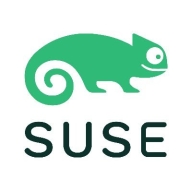

SUSE Linux Enterprise and Windows 10 both operate in the enterprise and desktop markets, each offering distinct advantages. SUSE Linux Enterprise stands out in enterprise environments due to its strong security and stability, whereas Windows 10 is favored for its speed and integration with Microsoft products.
Features: SUSE Linux Enterprise provides unique features like an offline repository on DVD, administration tools such as YaST, and strong support for Oracle and SAP HANA. It is secure, stable, and offers seamless integration with Windows Active Directory. Windows 10 emphasizes speed, built-in security with Windows Defender, and integration with Microsoft's ecosystem. Features like Hyper-V, the new Task Manager, and vast productivity tools also make it appealing.
Room for Improvement: SUSE Linux Enterprise could improve in package management, cloud integration, and pricing. Usability issues and a need for more APIs are noted. Windows 10 faces criticisms for frequent updates, security vulnerabilities, and performance slowdowns over time. Users find the updates intrusive and consider the pricing high.
Ease of Deployment and Customer Service: SUSE Linux Enterprise supports various deployment environments, including public and hybrid clouds. Its technical support is robust, but new users may face a steep learning curve. Windows 10 is mainly deployed on-premises, focusing on user friendliness but receiving mixed reviews on Microsoft's technical support.
Pricing and ROI: SUSE Linux Enterprise offers cost-effective subscription models with better ROI in high SAP deployments. It compares favorably against competitors like Red Hat. Windows 10's pricing is often seen as high, with bundled licenses. The ecosystem and productivity benefits may justify the cost for some.
I have seen a return on investment by switching our clusters from on-prem to Azure public cloud, using our same Bring Your Own Licenses, which saved costs on licensing.
SUSE Linux Enterprise provides a stable, secure, and well-supported platform for enterprise workloads, with powerful management tools and robust support for clustering, cloud, and containers.
The customer support is good; whenever we have opened a case, they have provided detailed explanations of the issues and resolutions.
I rate the customer service 10 out of 10 because SUSE has 24/7 availability support, extended support, security, multi-Linux distribution support, upgradation, and everything is user-friendly.
We have informed Microsoft, but the issue is still there, and it has been more than three to four months.
The customer service and support from Microsoft are quite responsive and generally good.
The Office 365 support is good, it takes a while sometimes to point to the problem, but they're good.
Its scalability is quite good since we are using Azure, which allows us to easily scale up or down our resources as needed.
SUSE Linux Enterprise is widely recognized for its strong scalability, making it suitable for organizations of all sizes, from small businesses to global enterprises.
For scalability, I would rate it a nine or ten because performance-wise, Windows 10 has never given me those issues.
I can increase the licensing amount easily when there is company growth or when new people join.
When HANA is utilized by many applications, I notice that while utilization does increase, we have never faced lagging or server unresponsiveness.
The challenges were related to third-party agents and their supportability.
I would rate the stability of the product an eight.
Security is a top concern, and further strengthening default security policies, simplifying compliance management, and integrating advanced vulnerability management tools would be a valuable improvement.
The software manager was different, making it challenging to install certain applications.
The license we subscribed to should carry over within the same instance family.
Microsoft can improve their Teams product because everybody uses Teams, and it's very clunky and unfriendly in terms of scrolling back, downloading files, and moving back and forth within the different teams.
Investment in Windows 10 may not be ideal as the world is changing with advancing technology in the AI age.
The transitions within Teams are not smooth, and call quality in meetings is not great.
Upgrading an instance results in overlapping or double subscription fees.
The licensing cost is a bit high.
For those buying a Windows license, it might be better to buy a Windows 11 license.
Windows is considered overpriced, especially given the normal software functionalities.
Windows 10 is cost-effective when compared to other competitors available such as Mac and Linux.
SUSE Linux had a clean user interface, which was a valuable feature for me.
It has a stable and reliable OS.
The LVM is very easy to configure, along with simple disk scanning compared to other systems.
When using mapping software such as QGIS or ArcGIS, the system remains stable, especially when handling heavy files.
The configuration management tools, such as SACM, are effective.
Windows 11 brings some AI features for Microsoft Copilot, which probably weren't as integrated into the previous version.
| Product | Market Share (%) |
|---|---|
| SUSE Linux Enterprise | 6.4% |
| Windows 10 | 2.8% |
| Other | 90.8% |


| Company Size | Count |
|---|---|
| Small Business | 8 |
| Midsize Enterprise | 11 |
| Large Enterprise | 20 |
| Company Size | Count |
|---|---|
| Small Business | 125 |
| Midsize Enterprise | 63 |
| Large Enterprise | 119 |
SUSE Linux Enterprise offers features like YaST for server management, seamless integration with Oracle and SAP, and a robust security setup. Renowned for stability, it efficiently supports workstations, SAP workloads, and cloud migrations across diverse industries.
SUSE Linux Enterprise is known for its lightweight design, high performance, and ease of installation. Its flexible architecture supports extensive documentation and efficient patching. The system uses the BTRFS file system for effective virtualization, and community support is significant. However, challenges include package updates causing conflicts, difficult initial setup and software management, high pricing, and support response times. Improvements in security compliance, cloud integration, hardware compatibility, and documentation are also needed.
What are SUSE Linux Enterprise's important features?
What benefits should users expect from using SUSE Linux Enterprise?
Industries like healthcare and banking use SUSE Linux Enterprise for secure transactions and structured application deployment. It is also a choice for organizations involved in testing, automation, and web development, offering support for SAP HANA integration and facilitating cloud migrations.
Windows 10 is one of Microsoft’s most advanced operating systems for personal computers (PCs), tablets, and other similar devices. To date this operating system is active on more than 1.3 billion personal computers worldwide.
Windows 10 has many features that make it arguably the most popular operating system for PCs on the planet. Included in these are a wealth of security features designed to stop malware from compromising both devices and networks. It has integrations for various multifactor authentication as well as non-password-reliant login technologies such as iris scanning. These keep networks safe from the moment that a user logs in. It also has security tools which not only identify, isolate, and remove threats, but also limit the damage that they can cause.
Benefits of Windows 10
Some of the benefits of using Windows 10 include:
Reviews from Real Users
The Windows 10 operating system stands out from the competition for a number of reasons. Two major ones are its ability to secure users from digital threats and its main app management screen, which gives users the ability to easily manage their applications.
One PeerSpot user who is the founder, president, and COO at an analyst firm, noted Windows 10’s impressive security suite when they wrote, “My impression is that the security via Windows Defender is good enough that I no longer feel a need for another third-party security solution, which had always been the case in the past. I think that perception still holds true.”
Mike K., a collaboration specialist at a comms service provider, takes note of the main app management screen when he writes, “I like the main window pane where you can sort your mostly used and different types of apps, such as OneDrive, Google Chrome, and Access. I can just open up the main window, and those apps are right there at my fingertips.”
We monitor all Operating Systems (OS) for Business reviews to prevent fraudulent reviews and keep review quality high. We do not post reviews by company employees or direct competitors. We validate each review for authenticity via cross-reference with LinkedIn, and personal follow-up with the reviewer when necessary.